Crafting herbal teas for the Gongfu ceremony combines traditional Chinese rituals with the art of herbal infusion. You'll need to select high-quality herbs that withstand multiple steepings, like adaptogenic roots or floral blends. Use small teapots and cups, often made of Yixing clay or porcelain, to enhance flavors. Pay attention to water temperature and steeping times, adjusting for delicate or robust herbs. Engage your senses by appreciating the aroma and evolving flavors through multiple infusions. This mindful practice offers not only a unique tea experience but also potential health benefits. Exploring seasonal blends and food pairings can further elevate your Gongfu herbal tea journey.
Understanding the Gongfu Tea Ceremony
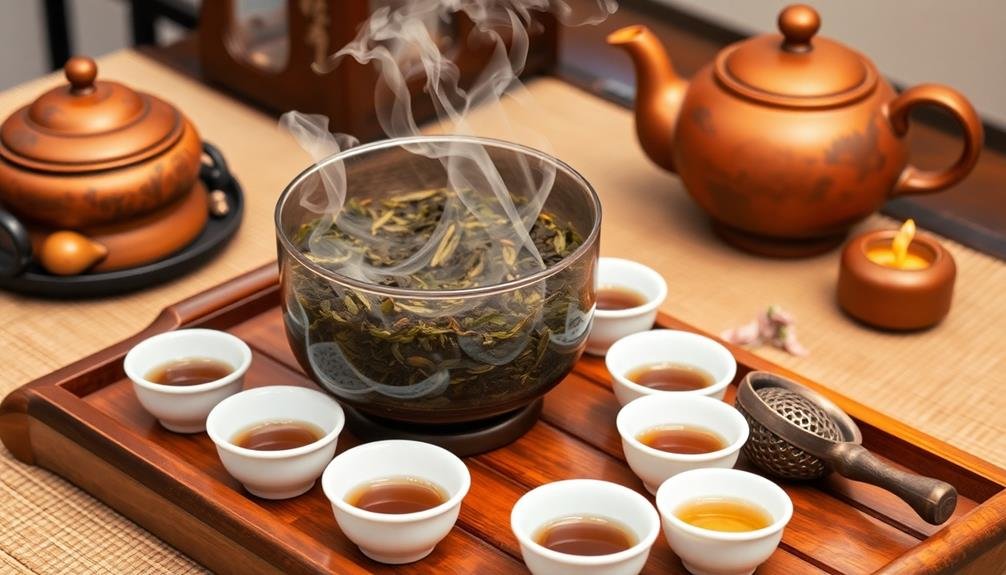
Before diving into herbal tea crafting, it's essential to grasp the basics of the Gongfu tea ceremony. This traditional Chinese ritual emphasizes precision, mindfulness, and appreciation of tea's nuances. You'll find that Gongfu, meaning "skillful" or "with effort," reflects the ceremony's meticulous nature.
In a Gongfu ceremony, you'll use small teapots and cups, typically made of Yixing clay or porcelain. The process involves multiple short steepings, allowing you to experience how the tea's flavor evolves. You'll start by warming the teaware, then add tea leaves, rinse them briefly, and proceed with successive infusions.
Each step in the ceremony has significance, from the way you pour water to how you handle the cups. You'll notice the emphasis on aroma, observing the tea's fragrance at various stages.
The ceremony also incorporates specific gestures and movements, creating a rhythmic, almost meditative experience. Understanding these elements will help you appreciate how herbal teas can be incorporated into this ancient practice, allowing you to craft blends that complement the ceremony's spirit and principles.
Selecting Suitable Herbs for Gongfu
With the fundamentals of the Gongfu ceremony in mind, let's focus on choosing the right herbs for your custom blends. When selecting herbs for Gongfu, prioritize those that can withstand multiple infusions without losing their flavor or medicinal properties.
Look for herbs with complex taste profiles that evolve over successive steepings. Consider using adaptogenic herbs like ginseng, ashwagandha, or holy basil, which can enhance the meditative aspects of the ceremony.
Chrysanthemum and osmanthus flowers add a delicate floral note, while ginger and licorice root provide warmth and sweetness. Don't overlook the power of aromatic herbs such as lemongrass, mint, or rosemary to engage the senses fully.
When crafting your blend, aim for a balance of flavors and therapeutic benefits. Combine herbs that complement each other both in taste and effect. For example, pair calming chamomile with invigorating peppermint for a balanced energy boost.
Remember to source high-quality, organic herbs to guarantee the best possible experience. Experiment with different combinations and ratios to find the perfect blend that resonates with your Gongfu practice and personal preferences.
Balancing Flavors in Herbal Blends
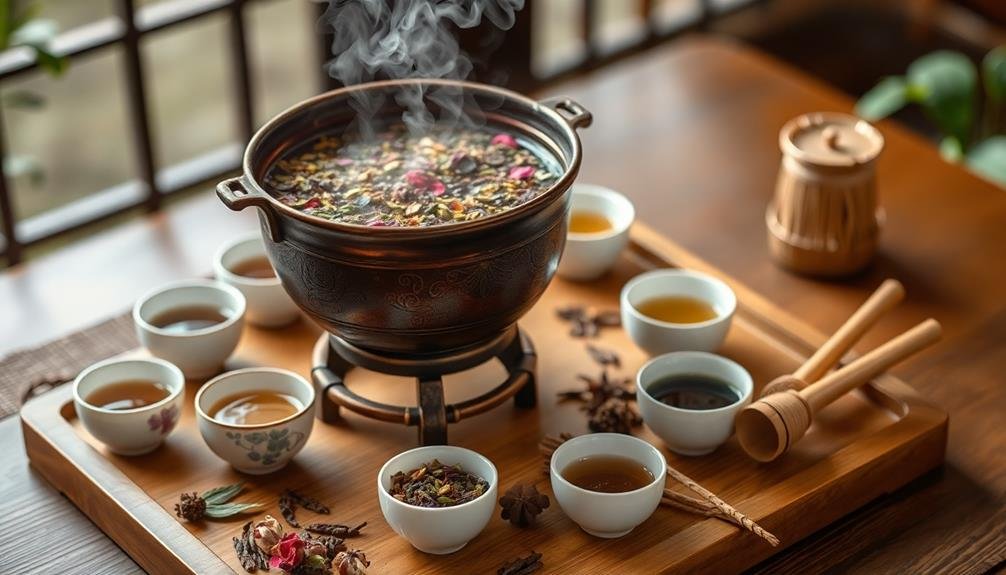
Creating a harmonious blend of herbs for your Gongfu ceremony requires a keen understanding of flavor profiles and how they interact. Start by identifying the primary flavor you want to highlight, then build around it with complementary tastes. Consider the five basic taste sensations: sweet, sour, bitter, salty, and umami.
When balancing flavors, aim for a well-rounded blend that doesn't overwhelm your palate. Use stronger herbs sparingly, and let milder ones form the base. Experiment with different ratios to find the perfect balance. Remember that some herbs can change flavor when brewed, so always test your blends before serving.
Here's a guide to help you balance flavors in your herbal blends:
| Base Flavor | Complementary Herbs | Balancing Herbs |
|---|---|---|
| Floral | Chamomile, Lavender | Lemon Balm, Mint |
| Earthy | Dandelion Root, Burdock | Cinnamon, Ginger |
| Citrusy | Lemongrass, Lemon Verbena | Hibiscus, Rose Hips |
| Spicy | Ginger, Turmeric | Licorice Root, Fennel |
Don't be afraid to mix unexpected flavors. Sometimes, the most surprising combinations create the most memorable blends. Trust your taste buds and keep refining your recipes until you achieve the perfect balance for your Gongfu ceremony.
Essential Equipment for Herbal Gongfu
Equipping yourself with the right tools is vital for a successful herbal Gongfu ceremony. You'll need a Gongfu tea tray to catch spills and provide a stable surface for your equipment.
A small Yixing clay teapot or a gaiwan is important for brewing your herbal blends, as these vessels enhance the flavors and aromas of your tea.
Don't forget about your tea cups—small, handleless cups are traditional for Gongfu style. You'll also need a fairness pitcher (cha hai) to guarantee even distribution of tea strength among cups.
A tea strainer is useful for catching small herb particles, while tea tongs help you handle hot cups safely.
For measuring and transferring dry herbs, invest in a tea scoop and a small digital scale. A tea needle or pick can help you clean out tea pot spouts.
To enhance your sensory experience, consider adding a tea pet—a small clay figurine that's "fed" with excess tea.
Preparing Herbs for Steeping
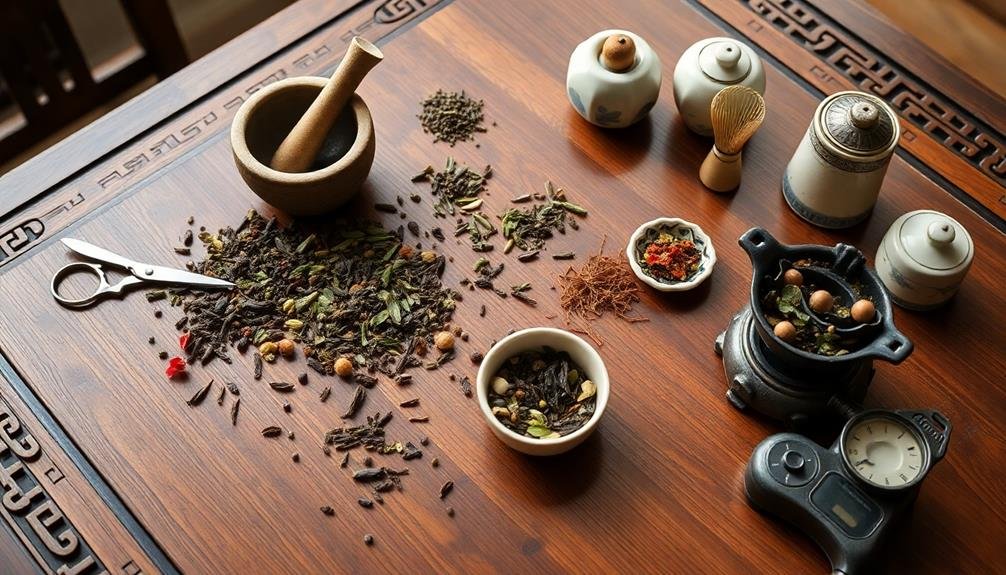
To prepare herbs for your gongfu ceremony, you'll need to start by selecting fresh, high-quality ingredients.
You'll want to clean your herbs thoroughly using appropriate techniques for each type.
Consider whether grinding or using whole leaves will best suit your chosen herbs and desired flavor profile.
Choosing Fresh, Quality Herbs
The foundation of a superb gongfu herbal tea lies in selecting high-quality, fresh ingredients. When choosing herbs for your ceremony, you'll want to focus on freshness, aroma, and overall quality. Look for vibrant colors and strong, pleasant scents, as these indicate the herbs are at their peak.
To guarantee you're getting the best herbs for your gongfu tea, consider these key factors:
- Source: Purchase from reputable suppliers or grow your own herbs to guarantee freshness and quality.
- Appearance: Choose herbs with bright, uniform colors and avoid those with discoloration or blemishes.
- Texture: Fresh herbs should feel crisp and firm, not limp or dry.
- Aroma: Select herbs with strong, characteristic scents that aren't musty or stale.
When possible, opt for organic herbs to avoid pesticides and other chemicals.
Store your herbs properly in airtight containers away from light and heat to maintain their freshness.
Proper Cleaning Techniques
Cleanliness is paramount when preparing herbs for your gongfu tea ceremony. Begin by gently rinsing your herbs under cool, running water to remove any dirt, dust, or debris. For delicate herbs like mint or chamomile, use a fine-mesh strainer to prevent damage. Shake off excess water and pat dry with a clean, lint-free cloth.
For roots and bark, you'll need to scrub them lightly with a soft brush to remove any stubborn soil. Slice or chop these tougher ingredients if necessary to guarantee even steeping.
When dealing with dried herbs, inspect them closely for any signs of mold or discoloration, discarding any compromised pieces.
Don't forget to sanitize your tools and preparation surfaces. Wash your cutting board, knife, and other utensils with hot, soapy water, then rinse thoroughly.
For an extra level of cleanliness, you can use a diluted vinegar solution to disinfect your workspace.
Grinding vs. Whole Leaves
When preparing herbs for your gongfu tea ceremony, you'll face a choice between grinding them or using whole leaves. Both methods have their merits, and your decision will impact the flavor, aroma, and overall experience of your herbal tea.
Grinding herbs offers several advantages:
- Increased surface area for faster infusion
- More intense flavors and aromas
- Easier blending of multiple herbs
- Smoother texture in the final brew
However, using whole leaves has its own benefits. You'll preserve the herb's natural oils and compounds, resulting in a more nuanced flavor profile. Whole leaves also allow for multiple infusions, as they release their flavors gradually over time.
Consider the specific herbs you're using when making your choice. Delicate leaves like mint or chamomile are best left whole, while tougher roots or barks may benefit from grinding.
If you're creating a blend, you might opt to grind some herbs while leaving others whole for a balanced infusion.
Ultimately, experiment with both methods to discover which produces the best results for your preferred herbal teas and gongfu ceremony style.
Water Temperature and Quality
Water, the foundation of any tea, plays a crucial role in gongfu ceremony. You'll want to pay close attention to both temperature and quality to achieve the best results.
For most herbal teas, water temperature should range between 190°F and 212°F (88°C to 100°C). However, some delicate herbs may require lower temperatures to prevent bitterness.
Use a thermometer or electric kettle with temperature control to guarantee precision. If you don't have these tools, bring water to a boil and let it cool for 30 seconds to a minute before pouring.
As for quality, always use fresh, cold water. Avoid distilled or softened water, as they lack minerals that contribute to flavor. Spring water or filtered tap water works best.
Don't reboil water, as it becomes depleted of oxygen and can affect the tea's taste. If your tap water has a strong chlorine smell, let it sit out for a few hours before using.
Steeping Times for Herbal Infusions
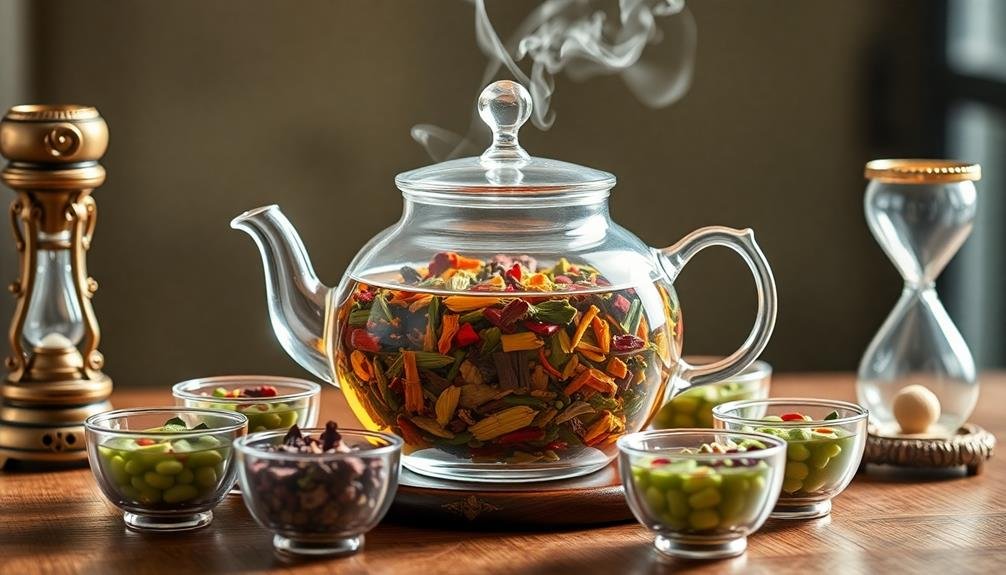
With water temperature and quality addressed, let's focus on steeping times for herbal infusions in gongfu ceremony.
Unlike traditional teas, herbal infusions often require longer steeping times to fully extract their flavors and beneficial compounds. You'll need to adjust your approach based on the specific herbs you're using.
For most herbal infusions in gongfu style, start with these general guidelines:
- Delicate herbs (e.g., chamomile, mint): 1-2 minutes
- Medium-bodied herbs (e.g., lemon balm, nettle): 3-5 minutes
- Robust herbs (e.g., ginger, rosehips): 5-7 minutes
- Roots and barks (e.g., licorice, cinnamon): 7-10 minutes
Multiple Infusions Technique
How can you maximize the flavor and benefits of your herbal infusions? The multiple infusions technique is your answer. This method involves steeping the same herbs multiple times, extracting different flavors and compounds with each infusion.
Start by using a higher ratio of herbs to water than you normally would. For your first infusion, use water at the appropriate temperature for your chosen herbs and steep for a shorter time than usual. This initial infusion will yield a concentrated, flavorful brew.
As you progress through subsequent infusions, gradually increase the steeping time. You'll notice that each infusion brings out different characteristics of the herbs. Early steeps may be more aromatic and delicate, while later ones can reveal deeper, more complex flavors.
This technique also allows you to extract more of the herbs' beneficial compounds, ensuring you get the most out of your ingredients. Don't forget to adjust the water temperature slightly between infusions if needed. Some herbs may require cooler water for later steeps to prevent bitterness.
Experiment with the number of infusions, as some herbs can yield up to 5-7 flavorful steeps.
Aroma Appreciation in Herbal Gongfu
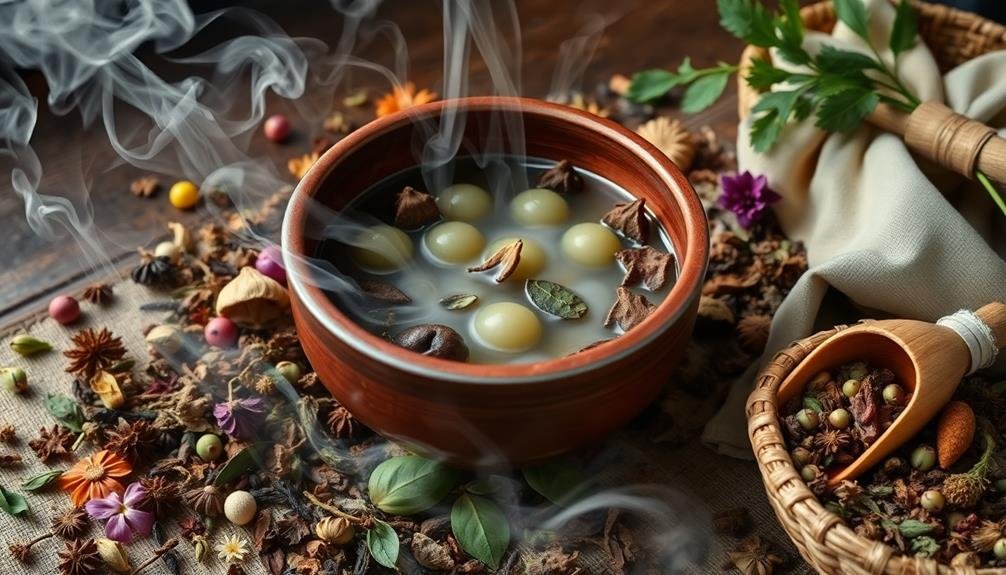
Aroma appreciation forms an essential part of the herbal gongfu experience. As you prepare your herbal infusion, take time to engage all your senses, particularly your sense of smell. The aroma of your chosen herbs can reveal much about their character and potential health benefits.
To fully appreciate the aroma of your herbal gongfu tea:
- Warm the gaiwan or teapot and add your herbs.
- Close the lid and let the dry herbs' scent develop for a few seconds.
- Lift the lid and inhale deeply, noting the initial fragrance.
- Pour hot water over the herbs, close the lid, and smell again.
You'll notice how the aroma evolves from dry to wet leaves. This transformation can hint at the flavor profile you're about to experience.
As you progress through multiple infusions, pay attention to how the aroma changes. Some herbs release their scent quickly, while others unfold gradually. By focusing on these aromatic nuances, you'll deepen your connection to the herbs and enhance your overall gongfu tea experience.
Tasting Notes and Flavor Profiles
You'll find the Herbal Tea Flavor Wheel invaluable for dissecting the complex tastes in your gongfu infusions.
As you sip, pay attention to the aroma and mouthfeel, noting how they evolve from the first to the last steep.
These sensory observations will help you articulate the unique flavor profiles of different herbal blends and enhance your overall gongfu experience.
Herbal Tea Flavor Wheel
Regarding understanding the complex flavor profiles of herbal teas, a flavor wheel serves as an invaluable tool for both novices and connoisseurs alike. This visual representation helps you categorize and identify the diverse tastes and aromas present in your brew.
As you explore the herbal tea flavor wheel, you'll notice it's divided into primary categories, each branching out into more specific descriptors.
To effectively use the herbal tea flavor wheel, follow these steps:
- Start at the center and work your way outward
- Identify the primary flavor category (e.g., floral, earthy, spicy)
- Narrow down to more specific descriptors within that category
- Compare and contrast multiple flavors to pinpoint the unique profile
Aroma and Mouthfeel Analysis
A sensory journey awaits as you explore the aroma and mouthfeel analysis of herbal teas.
Begin by observing the dry leaves, noting their visual appearance and initial scent. As you steep the tea, pay attention to the evolving aromas. Inhale deeply, identifying floral, fruity, earthy, or spicy notes.
When tasting, focus on the tea's initial impact, mid-palate sensations, and finish. Notice how flavors develop and change. Assess the tea's body, which can range from light and delicate to full and robust.
Consider the mouthfeel: Is it smooth, astringent, or velvety? Evaluate the tea's texture, which might be silky, crisp, or creamy.
Analyze the tea's complexity and balance. Look for harmony between different flavor components and how they interact.
Consider the tea's aftertaste and how long the flavors linger. Take note of any unique or unexpected elements that stand out.
Seasonal Herbal Blends for Gongfu
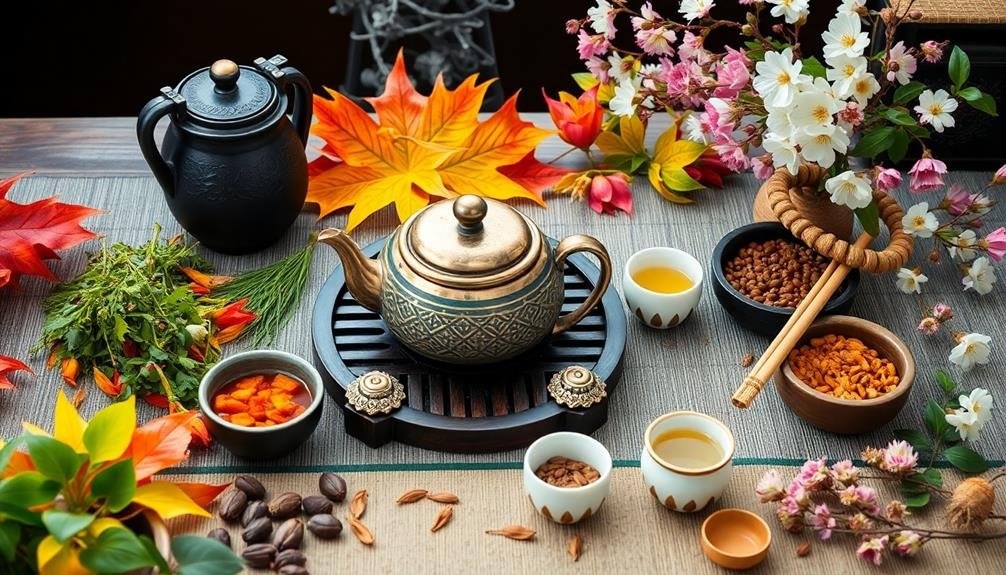
Four distinct seasons offer unique opportunities to craft herbal blends that complement the Gongfu tea ceremony. As you explore seasonal herbs, you'll find that each blend can enhance the ritual's ambiance and flavor profile.
For spring, consider light, floral notes that reflect new growth. Combine chamomile, lavender, and lemon balm for a revitalizing blend that pairs well with delicate green teas.
Summer calls for cooling herbs like mint, lemongrass, and chrysanthemum, which can balance rich oolongs.
As autumn arrives, turn to warming spices and herbs. Cinnamon, ginger, and rose hips create a comforting blend that complements roasted teas.
Winter's chill invites robust, nourishing herbs like elderberry, echinacea, and licorice root, perfect alongside bold black teas.
When crafting your seasonal blends, keep these key points in mind:
- Balance flavors to avoid overpowering the tea
- Consider the therapeutic properties of each herb
- Use local, seasonal ingredients when possible
- Experiment with proportions to find your ideal blend
Health Benefits of Herbal Gongfu
You'll find that herbal gongfu teas offer more than just a pleasant taste experience.
The antioxidant-rich brews can provide numerous health benefits, from fighting free radicals to supporting overall wellness.
Additionally, the mindful preparation and consumption of herbal gongfu tea can contribute to stress reduction, offering a moment of calm in your busy day.
Antioxidant-Rich Brew Benefits
Why should health-conscious tea enthusiasts consider herbal gongfu brewing? The antioxidant-rich benefits of this method can greatly enhance your overall wellness. When you brew herbs using the gongfu technique, you'll extract more beneficial compounds than traditional steeping methods.
Gongfu brewing maximizes the release of antioxidants, which are essential for:
- Combating free radicals that cause cellular damage
- Supporting your immune system's function
- Potentially reducing the risk of chronic diseases
- Promoting healthier skin and slowing signs of aging
You'll find that herbal gongfu teas often have a more robust flavor profile, indicating a higher concentration of beneficial compounds. This intensity isn't just about taste; it's a sign that you're getting more health-boosting elements in each sip.
The short, repeated infusions characteristic of gongfu brewing allow for ideal extraction of these compounds without over-steeping, which can lead to bitterness. By adopting this method, you're not only elevating your tea experience but also maximizing the potential health benefits of your chosen herbs.
Stress Reduction Properties
Beyond the antioxidant benefits, herbal gongfu brewing offers powerful stress-reducing properties. As you engage in the meticulous process of preparing and sipping your tea, you'll find yourself naturally slowing down and becoming more mindful. This ritualistic practice encourages deep breathing and relaxation, helping to lower cortisol levels and reduce anxiety.
Many herbs commonly used in gongfu tea have inherent calming effects. Chamomile, for instance, contains apigenin, a compound that binds to specific receptors in your brain, promoting sleepiness and reducing insomnia.
Lavender has been shown to decrease heart rate and blood pressure, while lemon balm can improve mood and cognitive performance.
The act of focusing on the present moment during the gongfu ceremony also contributes to stress reduction. As you observe the leaves unfurling and inhale the aromatic steam, you're practicing a form of meditation that can help clear your mind of worries.
The warmth of the tea cup in your hands and the soothing flavors on your palate further enhance this calming experience, making herbal gongfu an excellent tool for managing daily stress.
Pairing Herbal Teas With Food
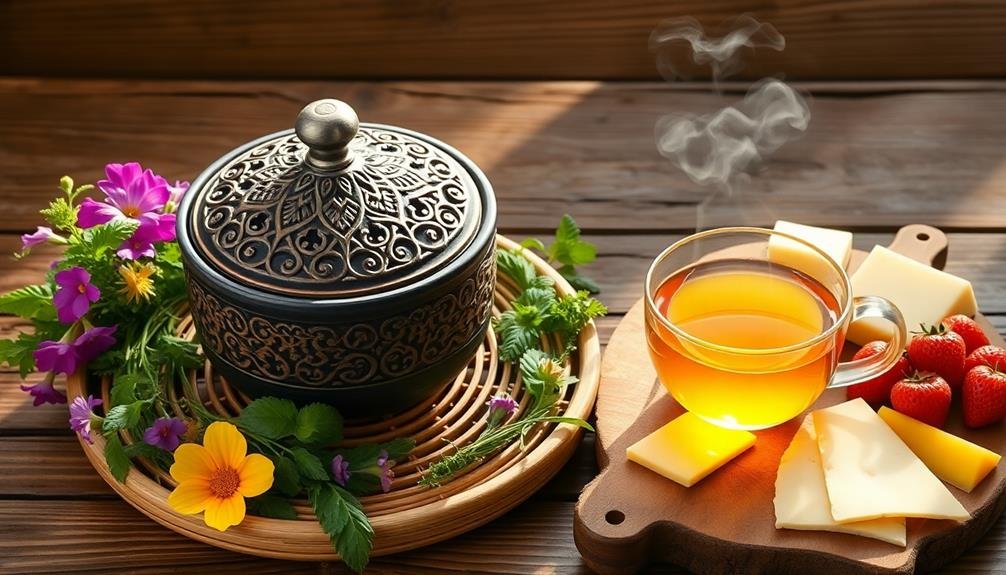
When it comes to pairing herbal teas with food for a gongfu ceremony, the key is to find complementary flavors that enhance both the tea and the dish.
You'll want to evaluate the tea's intensity, aroma, and taste profile to create a harmonious balance with your chosen food.
For a successful pairing, follow these guidelines:
- Match intensity: Pair delicate teas with light dishes and robust teas with heartier fare.
- Assess flavor profiles: Combine teas and foods with similar or contrasting notes.
- Balance sweetness and bitterness: Use sweet foods to offset bitter teas, or vice versa.
- Think about texture: Pair crisp teas with crunchy foods or smooth teas with creamy dishes.
You can experiment with pairings like chamomile tea and light pastries, peppermint tea with chocolate desserts, or ginger tea with spicy Asian cuisine.
Don't be afraid to try unexpected combinations; you might discover a new favorite pairing.
Frequently Asked Questions
Can I Use Store-Bought Herbal Tea Bags for Gongfu Ceremony?
While you can use store-bought herbal tea bags for gongfu ceremony, it's not ideal. You'll miss out on the full flavor and experience of loose leaf teas. Consider trying loose herbs for a more authentic and enjoyable ceremony.
How Long Can I Store My Homemade Herbal Tea Blends?
You can store your homemade herbal tea blends for up to 6 months in airtight containers, away from light and moisture. It's best to use them within 3 months for ideal freshness and flavor. Label them with the date you made them.
Are There Any Herbs to Avoid During Pregnancy When Practicing Gongfu?
You should avoid certain herbs during pregnancy, even for gongfu. Don't use blue cohosh, pennyroyal, or mugwort. It's best to consult your healthcare provider before consuming any herbal teas while pregnant, as some can be harmful.
Can I Mix Caffeinated Teas With Herbs for Gongfu Ceremony?
You can mix caffeinated teas with herbs for gongfu ceremonies. It's a great way to create unique blends. Just be mindful of caffeine content and potential herb interactions. Experiment with small amounts to find your perfect combination.
How Do I Clean and Maintain My Gongfu Teaware After Using Herbs?
You'll need to rinse your teaware thoroughly after using herbs. Don't use soap; instead, scrub gently with warm water. Dry completely to prevent mold. For stubborn residues, try soaking in a mixture of baking soda and water.
In Summary
You've now explored the art of crafting herbal teas for the gongfu ceremony. By understanding the ritual, selecting appropriate herbs, and mastering flavor balance, you're ready to create your own unique blends. Remember to invest in quality equipment and prepare your herbs with care. As you experiment with seasonal blends and explore health benefits, don't forget to pair your creations with complementary foods. Embrace this ancient practice and let your herbal gongfu journey begin!


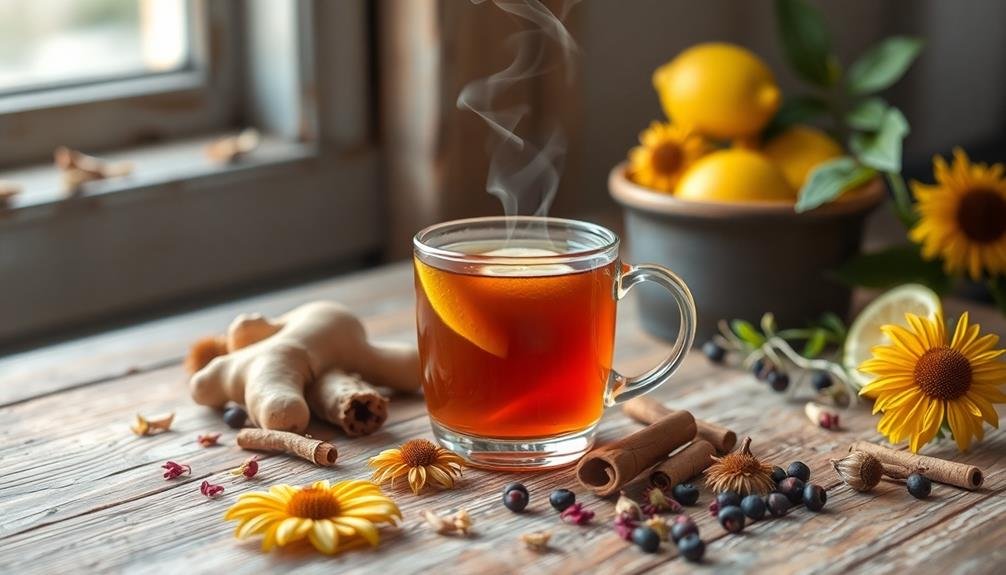
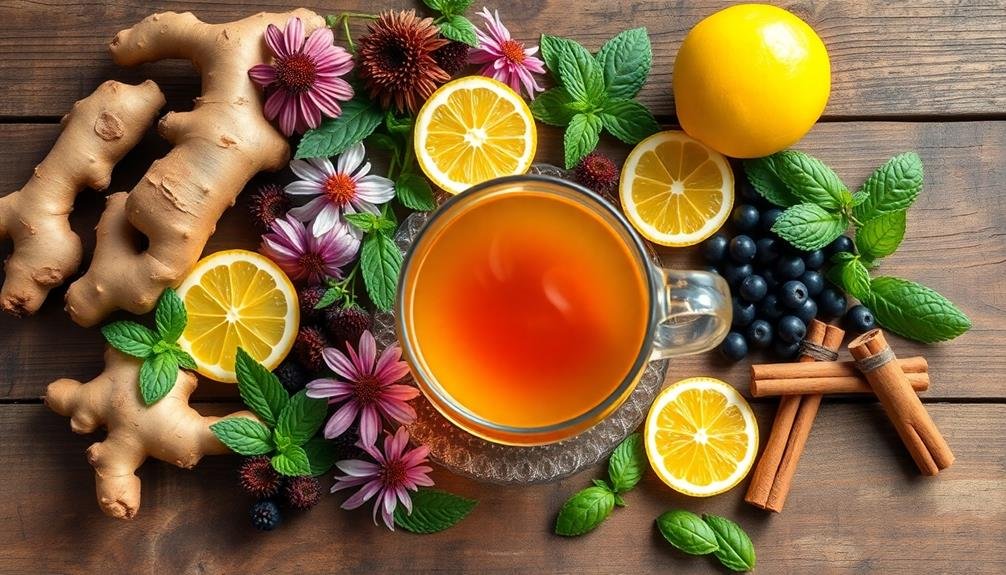
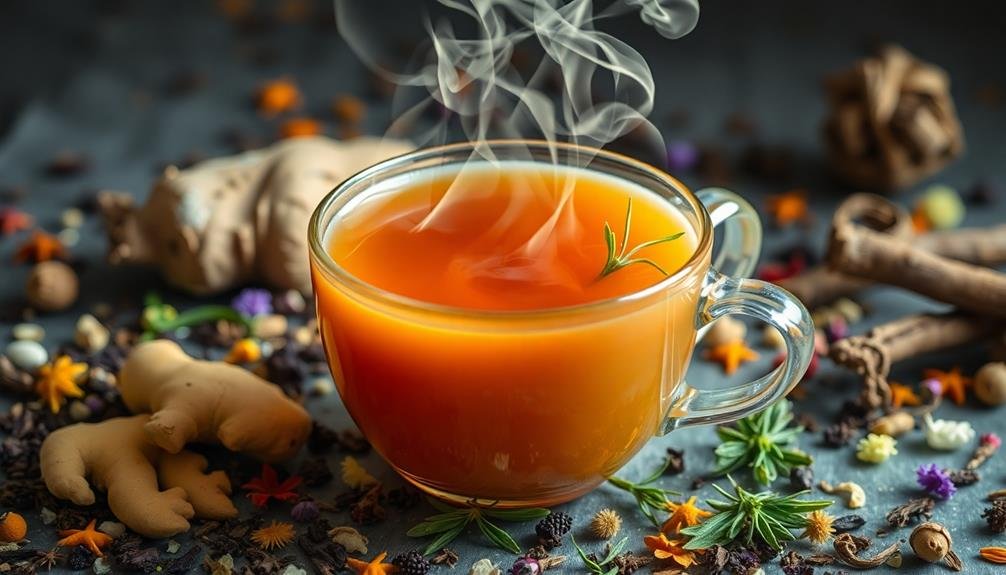
Leave a Reply